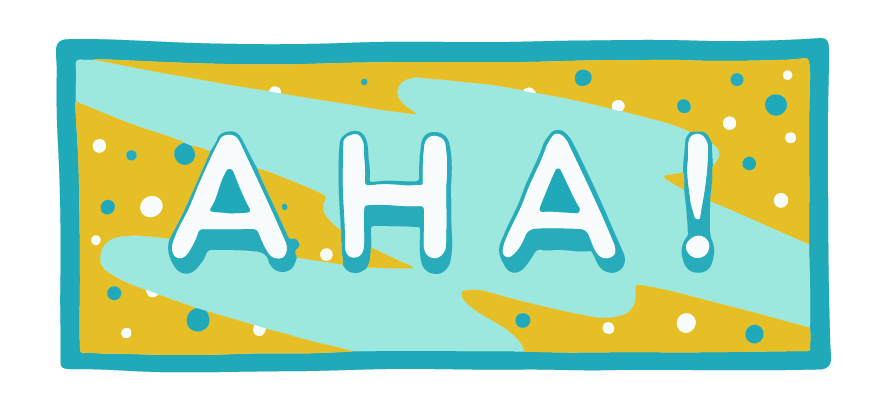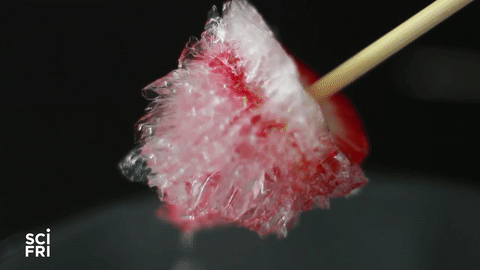Grade Level
All
minutes
15 min - 1 hr
subject
Chemistry
Activity Type:
crystallization, ice, nucleation, molecules, heat, Family activity, After School Activity
These Aha! resources are also available in Spanish!
When you cool water down below zero degrees Celsius (32 degrees Fahrenheit), it should freeze, right?
Well, that’s not always what happens.
Most of the time, when water dips below its freezing point, it transitions from a liquid state to a solid state, which you know as ice. However, under the right conditions, pure water can remain a liquid even when cooled to well below its freezing point. When water remains a liquid below its freezing point, it is called supercooled water.
How do you supercool water, and what causes it to finally freeze solid? To find out, let’s make supercool fruit pops. Here’s how:
Materials
Wooden skewers or toothpicks
Chunks of fruit, like bananas, strawberries, peaches, or pineapple
Ice and access to a freezer
Distilled water
Large glass or metal bowl
Small glass bowl or jar
Salt
Make supercooled water
- Freeze fruit on a skewer in the freezer for at least two hours.
- Fill a small glass jar one-third of the way with distilled water.
- Place the jar in the center of a large bowl and surround the jar with ice, making sure the ice comes up past the height of the water on the sides of the jar.
- Sprinkle a dusting of salt over the ice, being careful not to get any salt in the water in the jar.
- Rest a kitchen thermometer in the jar. Leave the jar in the bowl full of ice until the thermometer reads 30 F or below.
- When the water is below 30 F, carefully remove the thermometer from the jar. If your water is still liquid at this temperature, congrats! You’ve created supercooled water! If not, dump the ice that has formed in the jar and try again.
- Remove a frozen fruit skewer from the freezer and gently place it in the supercooled water in the jar. You should see ice crystals form around the fruit pop. Once the ice crystals have formed, remove the fruit skewer and observe (and eat) your frozen water masterpiece!
Be curious, ask questions, mess with stuff
- Does supercooled water look any different from room-temperature water? If the thermometer hadn’t been in the water as it cooled, would you have been able to tell from its appearance that it was supercooled?
- What happened when you put the frozen fruit into the supercooled water? Be as specific as possible.
- How did the water change? Did ice crystals form? If so, where did they begin to form? How did they grow?
- Did all the water in the jar turn into ice crystals, or did some water remain? Try putting more frozen fruit in whatever water remained in the jar. Did that fruit instantly freeze, too? Why or why not? Use a kitchen thermometer to test your prediction.
- Examine the ice crystals that formed on your fruit pop. What do they look like? Are they smooth and glassy, or are they spikey? Is the ice that formed thick or thin?
AHA! Ice crystals help supercooled water freeze!
In order to get an idea of what just happened in your glass jar, you have to picture water at the molecular level. Each water molecule consists of a pair of hydrogen atoms bonded to one oxygen atom. In a warm liquid state, water molecules bounce around and collide with one another constantly and randomly, propelled by energy in the form of heat.
But when water is frozen solid, water molecules don’t really move around. Instead, they’re arranged in a rigid, highly organized, three-dimensional grid called a crystal, where they vibrate in place. If you’ve ever noticed frost on a window, peered into an ice cube, or seen a snowflake, you’ve observed the results of this molecular organization process, called crystallization.
So, how do you get water molecules in a liquid state to arrange themselves into crystals? First you have to slow them down—and to do that, you have to drop the temperature, just like you did when you chilled the water in an ice bath. Second, you have to give those chilled water molecules something to crystallize around, called a “seed.”
In your experiment, the seed you provided was in the form of tiny ice crystals on the outside of your frozen fruit pop! Those tiny crystals acted like a pattern, or template, for water crystal formation, providing a guide to help water molecules arrange themselves into a crystal lattice. The initial formation of crystals around a seed crystal is called nucleation, and is an essential first step in the process of crystallization.
Many substances can seed crystallization in supercooled water, even impurities like dust, other minerals, and tiny air bubbles. That’s why it’s best to use purified water like distilled or filtered water when making supercooled water!
Experiment more, make predictions. It’s what scientists do.
- Ask questions: What other things could you use as a seed crystal for water crystallization?
- Modify the experiment: Repeat this experiment, but instead of putting the fruit pop into the supercooled jar of water, hold your frozen fruit pop over the sink and pour the supercooled water over the top of it. How does the ice formed with this method differ from the ice that was formed when you dipped the fruit into the supercooled water?
- Make a prediction: What other substances besides frozen fruit would cause crystal formation in supercooled water? Can you make ice crystals form on a non-frozen fruit pop? What about on a jellybean or a plain ice cube? Repeat the experiment using different substances to seed crystallization, adding the ice in your bowl as needed to keep your experiment cool.
- Document your results: Write down all the different versions of this experiment that you try, snapping pictures of the ice that you create, and describing differences in ice crystals between experiments.

Aha! by Science Friday, is a series of short science experiments that you can do in 15 minutes or less, with materials you can find at home.
Meet the Writer
About Ariel Zych
@arieloquentAriel Zych was Science Friday’s director of audience. She is a former teacher and scientist who spends her free time making food, watching arthropods, and being outside.
